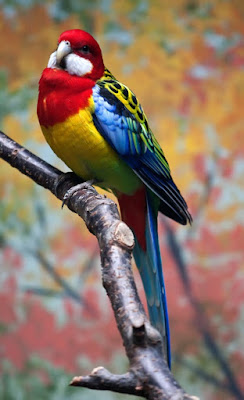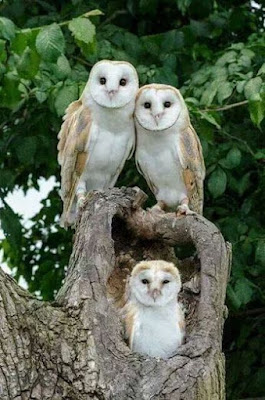Bird's are Amazing
I love birds. They are my favorite animal.They're free to fly all around without a worry in the world.
Birds Don't Worry
"Therefore I tell you, do not worry about your life, what you will eat or drink; or about your body, what you will wear. Is not life more important than food, and the body more important than clothes? Look at the birds of the air; they do not sow or reap or store away in barns, and yet your heavenly Father feeds them. Are you not much more valuable than they? Who of you by worrying can add a single hour to his life?"
Matthew 6:25-27 New International Version
Bird Pictures
Red-billed blue magpies
This brightly colored member of the crow family has a pair of striking white and blue tail feathers that can grow up to 17 inches long. The showy tail probably plays a role in courtship displays. Red-billed blue magpies make their home in mountain forests. They are often seen in small groups searching the treetops for insects, eggs, fruits and nectar. The magpies will also rob nests of eggs (and even chicks). At times they also hunt on the ground for small mammals, snakes, lizards, centipedes, and snails.
Eastern Rosella
Rosellas are often sought out as pet birds because of their striking appearance. A well-socialized, hand-tamed rosella can be a sociable companion. They are native to southeast Australia and nearby islands. It inhabits open forests, woodlands, gardens as well as parks, and its wild diet consists many of native grass seeds, herbs, fruits and flowering buds.
Paradise flycatchers
Paradise flycatchers are diminutive woodland birds found in most parts of South Africa and further north. Their bright colours, noisy calls and high tolerance for human presence, though, make them rather special to watch. They have very attractive, neat nests created from grass, bark, lichen and spider webs.
Black-hooded Oriole
The Black-hooded Oriole (Oriolus xanthornus) i is a resident breeder in tropical southern Asia from India and Sri Lanka east to Indonesia, where they inhabit woodland and cultivation.
Purple Honeycreeper
Purple Honeycreeper’s main range is in Amazonia, but is also found along northern and western coasts of the continent. It is found in a wide variety of forest types, even extending to gardens, partially cleared areas, and plantations, but typically forages in the treetops, often in pairs and frequently joining other species either in roving flocks or at a flowering tree. Males are mainly deep violet-blue with a black throat patch and wings, and bright yellow legs, whilst females are principally green, becoming streaked below, and has a buffy throat and cheeks.
Sandhill Crane
These tall, gray-bodied, crimson-capped birds breed in open wetlands, fields, and prairies across North America. They group together in great numbers, filling the air with distinctive rolling cries.
Mountain Bluebird
The lovely mountain bluebird (Sialia arctcia) was designated the official state bird of Idaho in 1931. The male mountain bluebird is a brilliant sky-blue, the female is gray with blue on her wings and tail. The bluebird family is especially plentiful in Idaho's mountains. Idaho recognizes two bird symbols; the peregrine falcon is the official state raptor. The mountain bluebird is also the state bird of Nevada.
American Avocet
With its elegant profile and striking coloration, the American Avocet is unique among North American birds. In summer it can be found in temporary and unpredictable wetlands across western North America where it swings its long upturned bill through the shallow water to catch small invertebrates.
Harris's Sparrow
This big, elegant sparrow is a bird of the heartland, nesting in north-central Canada, wintering mainly on the southern Great Plains. Because of its remote habitat and shy behavior in summer, its nest was not discovered until 1931, long after those of most North American birds.
The Mallard is the most familiar wild duck to many people, and the ancestor of most strains of domesticated ducks. In many places this species has managed to domesticate itself, relying on handouts in city parks. Although barnyard and feral ducks may be dumpy and ungainly creatures, the ancestral wild Mallard is a trim, elegant, wary, fast-flying bird.
Peacock
The peacock (also known as peafowl) is a medium sized bird most closely related to the pheasant. Unlike it's common pheasant cousin that inhabits areas of the Northern Hemisphere, the peacock is found in warmer climate of the Southern Hemisphere, with the peacock being most commonly found in India.
American Robin
American Robins are common sights on lawns across North America, where you often see them tugging earthworms out of the ground. Robins are popular birds for their warm orange breast, cheery song, and early appearance at the end of winter.
Canadian Geese
Canadian Geese are the most widely distributed geese in North America, with a range that stretches across the Arctic and temperate regions of North America.They also occur in northern Europe, on the Kamchatka Peninsula in eastern Siberia, eastern China and throughout Japan. Introduced populations have also established themselves in New Zealand. This species has adapted well to living in urban and suburban areas and are commonly found on lakes, ponds and rivers.
Yellow warbler
North America has more than 50 species of warblers, but few combine brilliant color and easy viewing quite like the Yellow Warbler. In summer, the buttery yellow males sing their sweet whistled song from willows, wet thickets, and roadsides across almost all of North America. The females and immatures aren’t as bright, and lack the male’s rich chestnut streaking, but their overall warm yellow tones, unmarked faces, and prominent black eyes help pick them out.
The Nutmeg Mannikin
The Nutmeg Mannikin (Lonchura punctulata) is also known as the Scaly-breasted Munia, Ricebird and Spice Finch. It is a resident of tropical southern Asia from India and Sri Lanka east to the Philippines. Because of its striking beauty and gregarious behavior it is a popular cage bird. Its accidental release from that status appears to account for its initial presence in the United States. eBird indicates it is regularly reported in Costal California, Southeast Florida, the Gulf Coast of Texas and the Puget Sound area in Washington. Flocks of fifteen or more have been observed visiting bird feeders in Orange County, CA
European bee-eater(Merops apiaster)
European bee-eater is one of the most colorful birds of our fauna. As its name suggests, it is a specialist in the use of bees, but also eat other flying insects. Besides its colorful, one of the most striking of birds europeas-, is easily recognizable by its distinctive claim, which constantly emit while flying and can be heard over long distances.
Owls
An owl can turn its face upside down and swing its head around and look behind its back. They can't move their eyes which is why they can move their heads all around. Their vision and hearing is better than humans. Owls are nocturnal which means they are active during the night and roost during the day. If possible they swallow their prey whole and have the ability to regurgitate pellets of bone and other non digestible bits. They prey on small to medium sized non-domesticated mammals. Owls typically mate for life and breed in January and February. You can hear their hoo hoo's after sunset or before dawn from almost a mile away. Owls are truly amazing.
Owl Pictures
Northern Pygmy-Owl
In western forests, this little owl is often active by day. It may fly fast and low from one tree to the next and then swoop up to take a high perch, rather like a shrike.
Barn Owls
Barn Owls require large areas of open land over which to hunt. This can either be marsh, grasslands, or mixed agricultural fields. For nesting and roosting, they prefer quiet cavities, either in trees or man-made structures such as barns or silos.
Barred Owl
The rich baritone hooting of the Barred Owl is a characteristic sound in southern swamps, where members of a pair often will call back and forth to each other. Although the bird is mostly active at night, it will also call and even hunt in the daytime.Great Horned Owl
Found almost throughout North America and much of South America is this big owl. Aggressive and powerful in its hunting (sometimes known by nicknames such as "tiger owl"), it takes prey as varied as rabbits, hawks, snakes, and even skunks, and will even attack porcupines, often with fatal results for both prey and predator.
Great Grey Owl
A big nightbird, haunting woods of the far north and certain high mountains of the west. Its great size is partly illusion: it has very thick fluffy plumage, and its body size is smaller than it would appear, so it preys mostly on tiny rodents.
White Owl
The legend of the White Owl means many things to many people. To the Mayan it is a messenger who brings a warning that the world has become so out of balance that we need to change. The white owl is also a guardian that allows us to see with clarity beyond fear and illusion.Hoo's there?
If you see an Owl during the day...
Be quiet, and try not to be heard,
For this is the resting, quiet time
Of this truly amazing type of bird.
At night the Owl is wide awake.
He sees and hears what's all about.
And when he flies close to the ground,
He's searching for his prey, no doubt.
When he spots the meat he wants...
He swallows it whole, with great haste.
And magically in a few short hours,
He'll spit out all the bones and waste.
The Owl has quite a mysterious look,
Of wisdom, fantasy and superstition.
Their habits, sounds, interests and more,
Surely deserve great recognition.
by Gina Bisceglia
Please leave comments and questions in the comments section below.























No comments:
Post a Comment